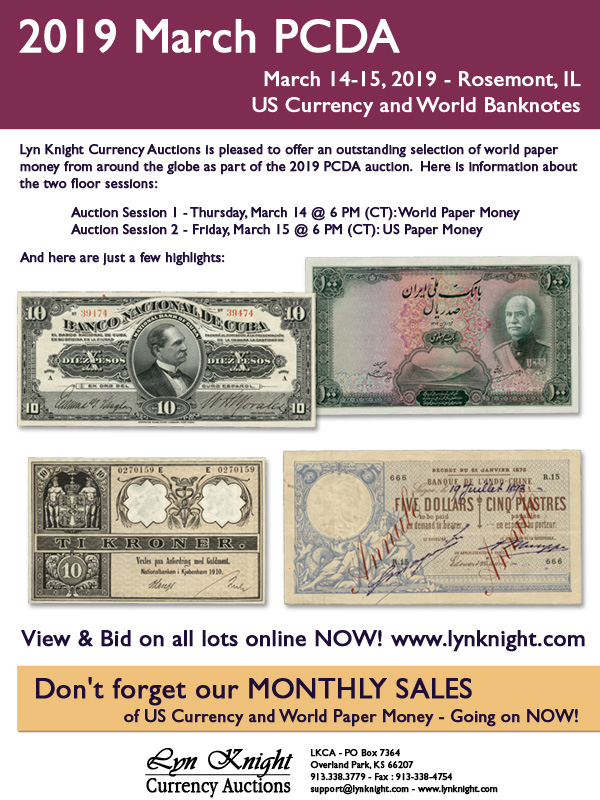
PREV ARTICLE
NEXT ARTICLE
FULL ISSUE
PREV FULL ISSUE
VOCABULARY TERMS: CAST, CASTINGDick Johnson submitted these entries from his Encyclopedia of Coin and Medal Terminology. Thanks! -Editor
Cast, Casting. Made from molten metal poured into a mold. Metalcasting is the world's oldest metal technology, spanning more than 5,000 years in man's history, yet it is as modern and necessary as the most recent model or medallic item. The ease in which molding can be done is why artists use this technique to cast designs in their own studios (see also plaster casting) and yet why a giant industry exists for casting metal parts from the size of pins to steamship propellers. There are several casting techniques – and there has been more development in this field in the last 50 years than in all the previous 5,000. Yet techniques from prehistoric times, as sand casting, are still in common use today. Patterns for coin and medal designs have been cast in metal (then reduced by pantograph to create dies the required size as small as a dime). Also casting has been used for making the end products, as many cast art medals – and coins from early China – attest. In contrast to the foundry casting industry, medallic casting is small by comparison. Coins and medals are small size, their shape is generally flat, and they lack complex forms. They have no undercuts and are the simplest form of relief casting. Medallions larger than six inches – because of the limitations of size in diestriking in presses – are always cast. Medallic objects, often in somewhat more complex form, are usually cast. Thus the medallic field has been casting glyptic objects since Pisanello created the first cast medal in 1438. Cast Coins, Medals and Plaques
Cast medals are somewhat more common and genuine. Such cast medallic items sometimes have only one side (called single-sided), but may have two sides, (called double sided if both sides are in the mold), or may have two sides where two single-sided cast medals joined together (called cast double). Plaquettes are sometimes cast (if not diestruck), plaques are always cast because of their larger size (over eight inches). Thus plaques, always intended for display, have a flat back with some means for hanging or upright support cast on back. Cast versus Struck Surfaces
Generally a cast surface is not completely smooth but may exhibit the roughness of the surface of the mold or contain pits (blowholes from escaping occluded gas). Struck surfaces are more likely to be smooth with no inherent imperfections. Cast lettering appears rounded and less distinct. Struck lettering can be sharper and more angular at the top of the letters and where the sides of lettering meet the field. Casting is a slow operation, but can be speeded up by diecasting, forcing hot metal into a die mold (but only metals with a low temperature melting point can be diecast – as white metal zinc alloys). For production runs requiring high production speeds, coins and medals are required to be struck. Diestriking in modern presses is preferred to casting for another important reason – far more intricate detail can be reproduced by dies than by molds. Cast Counterfeits
More recently counterfeiters have been making dies or molds by edm (but this process has a characteristic pock-marked surface evident under magnification, unlike the smooth surface of conventional die making methods or cast porosity). Medallic Casting Techniques
Looking for the meaning of a numismatic word, or the description of a term? Try the Newman Numismatic Portal's Numismatic Dictionary at: https://nnp.wustl.edu/library/dictionary Or if you would like a printed copy of the complete Encyclopedia, it is available. There are 1,854 terms, on 678 pages, in The Encyclopedia of Coin and Medal Technology. Even running two a week would require more than 19 years to publish them all. If you would like an advance draft of this vital reference work it may be obtained from the author for your check of $50 sent postpaid. Dick Johnson, 139 Thompson Drive, Torrington, CT 06790. 
Wayne Homren, Editor The Numismatic Bibliomania Society is a non-profit organization promoting numismatic literature. See our web site at coinbooks.org. To submit items for publication in The E-Sylum, write to the Editor at this address: whomren@gmail.com To subscribe go to: https://my.binhost.com/lists/listinfo/esylum All Rights Reserved. NBS Home Page Contact the NBS webmaster 
|